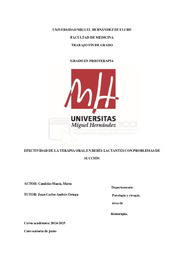Por favor, use este identificador para citar o enlazar este ítem:
https://hdl.handle.net/11000/37489Registro completo de metadatos
| Campo DC | Valor | Lengua/Idioma |
|---|---|---|
| dc.contributor.advisor | Andrés Ortega, Juan Carlos | - |
| dc.contributor.author | Candelas Maciá, María | - |
| dc.contributor.other | Departamentos de la UMH::Patología y Cirugía | es_ES |
| dc.date.accessioned | 2025-09-24T07:28:28Z | - |
| dc.date.available | 2025-09-24T07:28:28Z | - |
| dc.date.created | 2025-05-19 | - |
| dc.identifier.uri | https://hdl.handle.net/11000/37489 | - |
| dc.description.abstract | Introducción: El proceso mediante el cual un recién nacido o lactante obtiene su alimento se denomina succión nutritiva. La alimentación al pecho materno tiene beneficios inmunológicos y nutritivos, entre otros. El problema de las disfunciones orales en lactantes tiene impacto tanto en el niño, como en la familia, por esta razón, es fundamental contar con estrategias terapéuticas que faciliten la recuperación de la función oromotora y mejoren la calidad de vida del lactante y su entorno. Objetivos: la finalidad última del trabajo es valorar la efectividad de la terapia oral (Fucile, PIOMI, NNS) en lactantes con problemas de succión. Material y métodos: se llevó a cabo una búsqueda avanzada de artículos científicos en las bases de datos PubMed, Embase, Cochrane Library y Web of science desde el año 2010 hasta la actualidad. Resultados: Tras aplicar los criterios de inclusión en la búsqueda, se encontraron 25 estudios, los cuáles fueron analizados para determinar si tiene efecto la terapia oral. Conclusión: La terapia oral, en cualquiera de las formas estudiadas en esta revisión presenta beneficios tanto en la adquisición de una alimentación oral independiente, como en el aumento del volumen ingerido o la ganancia de peso. Además, mediante ella, se consiguen mejores puntuaciones en distintas escalas como LATCH o NOMAS. Sin embargo, se requiere más evidencia de los efectos a largo plazo y una mayor estandarización de protocolos para establecer a nivel internacional. | es_ES |
| dc.description.abstract | Introduction: The process by which a newborn or infant obtains its food is called nutritive sucking. Breast feeding has immunological and nutritional benefits, among others. The problem of oral dysfunctions in infants has an impact on both the child and the family. For this reason, it is essential to have therapeutic strategies that facilitate the recovery of oral-motor function and improve the quality of life of the infant and its environment. Objectives: the ultimate aim of this study is to evaluate the effectiveness of oral therapy (Fucile, PIOMI, NNS...) in infants with sucking problems. Material and methods: An advanced search of scientific articles was carried out in the databases PubMed, Embase, Cochrane Library and Web of science from 2010 to the present. Results: After applying the inclusion criteria in the search, 25 studies were found, which were analyzed to determine whether oral therapy has an effect. Conclusion: Oral therapy, in any of the forms studied in this review, has benefits both in the acquisition of independent oral feeding and in the increase of volume intake or weight gain. In addition, it achieves better scores in different scales such as LATCH or NOMAS. However, more evidence of the long-term effects and a greater standardization of protocols is required to be established at international level | es_ES |
| dc.format | application/pdf | es_ES |
| dc.format.extent | 43 | es_ES |
| dc.language.iso | spa | es_ES |
| dc.publisher | Universidad Miguel Hernández | es_ES |
| dc.rights | info:eu-repo/semantics/openAccess | es_ES |
| dc.rights | Attribution-NonCommercial-NoDerivatives 4.0 Internacional | * |
| dc.rights.uri | http://creativecommons.org/licenses/by-nc-nd/4.0/ | * |
| dc.subject | Terapia oral | es_ES |
| dc.subject | Problemas de succión neonatal | es_ES |
| dc.subject | Intervención temprana | es_ES |
| dc.subject.other | CDU::6 - Ciencias aplicadas | es_ES |
| dc.title | Efectividad de la terapia oral en bebés lactantes con problemas de succión | es_ES |
| dc.type | info:eu-repo/semantics/bachelorThesis | es_ES |

Ver/Abrir:
TFG CANDELAS MACIÁ, MARÍA.pdf
1,48 MB
Adobe PDF
Compartir:
 La licencia se describe como: Atribución-NonComercial-NoDerivada 4.0 Internacional.
La licencia se describe como: Atribución-NonComercial-NoDerivada 4.0 Internacional.
.png)